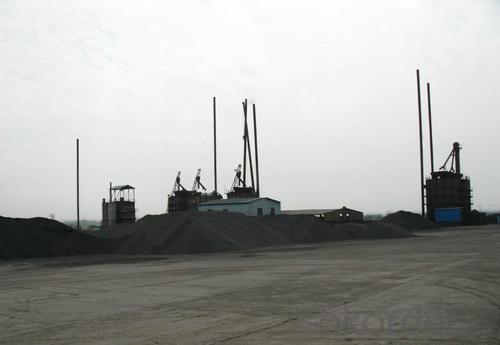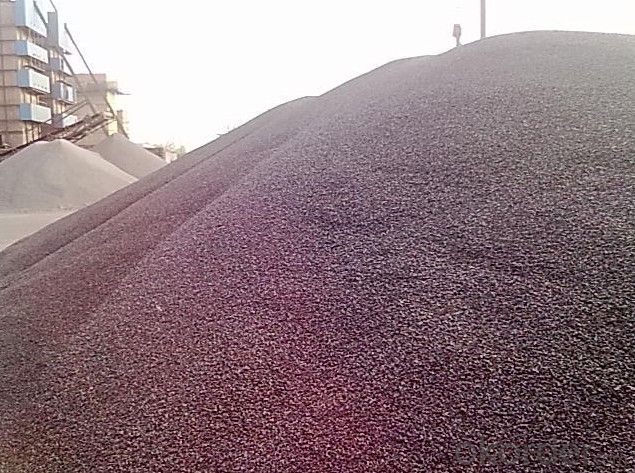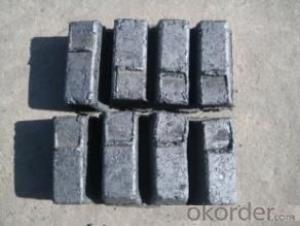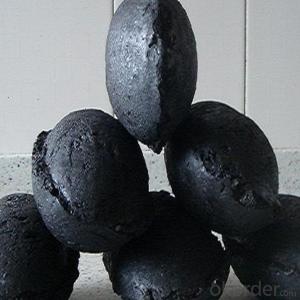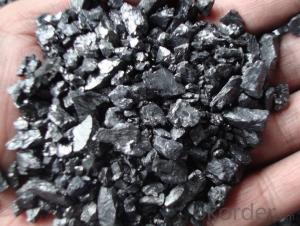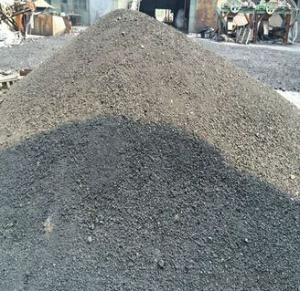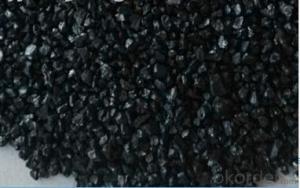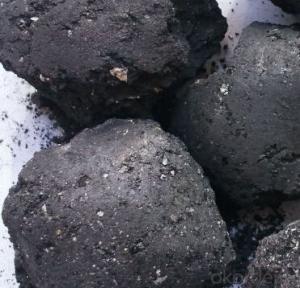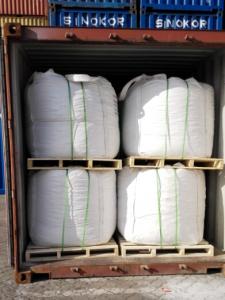High Carbon Calcined Anthracite Coal Specifications
- Loading Port:
- Tianjin
- Payment Terms:
- TT OR LC
- Min Order Qty:
- 1 m.t.
- Supply Capability:
- 10000000 m.t./month
OKorder Service Pledge
OKorder Financial Service
You Might Also Like
1.Structure of Calcined Anthracite Description
This product is made from high-quality anthracite as raw materials, shape of columnar respectively, particles, powder, such as spherical shape, has high strength, adsorption speed, adsorption capacity, high specific surface area is larger, developed pore structure, pore size is between coconut shell activated carbon and wood charcoal.
Mainly used for high-end air purification, waste gas treatment, waste incineration, high pure water treatment, wastewater treatment, wastewater treatment, aquatic animals, desulphurization and denitration, and can effectively remove the impurities and contaminants in the gas and liquid as well as a variety of gas separation and purification, also can be widely used in all kinds of low boiling point substances adsorption recycling, deodorization oil removal, etc.
2.Main Features of the Calcined Anthracite
Calcined Anthracite is a kind of filter used in water treatment. It is suitable for the treatment of common acid, the middle degree alkali. This product has large surface area, and its various indexes all exceed the Construction Department’s standard. Anthracite filter is especially selected from the deep well minerals, so it includes the highest percentage of carbo. It must have been filtered and washed to make sure it can be used for water filting. Since it has better granular maintaining ability, so it can improve the floating granular’s cleaning ability.
3. Calcined Anthracite Images


4. Calcined Anthracite Specification

5.FAQ of Calcined Anthracite
1). Q: Are you a factory or trading company?
A: We are a factory.
2). Q: Where is your factory located? How can I visit there?
A: Our factory is located in ShanXi, HeNan, China. You are warmly welcomed to visit us!
3). Q: How can I get some samples?
A: Please connect me for samples
4). Q: Can the price be cheaper?
A: Of course, you will be offered a good discount for big amount.
- Q: What are carbon credits?
- Carbon credits are a market-based mechanism designed to reduce greenhouse gas emissions and combat climate change. They represent a unit of measurement that quantifies the reduction, removal, or avoidance of one metric ton of carbon dioxide (or its equivalent) from being released into the atmosphere. The concept behind carbon credits is based on the idea that certain activities or projects can help offset the emissions produced by other activities. For instance, renewable energy projects, such as wind farms or solar power plants, can generate carbon credits by displacing the need for fossil fuel-based electricity generation. Similarly, projects that focus on reforestation or afforestation can absorb carbon dioxide from the atmosphere, creating credits. These carbon credits can be bought and sold in the carbon market, allowing companies or individuals to compensate for their own emissions by purchasing credits from projects that have successfully reduced or removed carbon dioxide from the atmosphere. By doing so, they support environmentally friendly initiatives and contribute to the overall reduction of greenhouse gases. The carbon credit system operates on the principle of creating financial incentives for emission reduction activities. It encourages businesses to invest in cleaner technologies and practices by providing a monetary value to the reduction of carbon emissions. In turn, this helps drive the transition to a low-carbon economy and promotes sustainable development. Carbon credits play a crucial role in international efforts to address climate change. They are often used as a compliance mechanism for countries or companies to achieve their emission reduction targets, as outlined in international agreements like the Kyoto Protocol or the Paris Agreement. Additionally, they contribute to the overall goal of limiting global temperature rise by incentivizing emission reductions beyond regulatory requirements. While carbon credits have been criticized for potentially allowing companies to continue polluting by simply purchasing credits, they remain an important tool in the fight against climate change. They provide economic benefits to sustainable projects and encourage the transition to cleaner technologies, ultimately helping to mitigate the environmental impact of human activities.
- Q: How is carbon used in the manufacturing of electronics?
- Carbon is used in several ways in the manufacturing of electronics. One of the primary uses of carbon in electronics is as a key component in the production of carbon nanotubes. These nanotubes have exceptional electrical conductivity and mechanical strength, making them ideal for use in various electronic devices. For instance, carbon nanotubes can be used to create high-performance transistors, which are essential components in computer chips. Additionally, carbon is utilized in the manufacturing of batteries for electronic devices. Carbon-based materials, such as graphite, are commonly used as the anode material in lithium-ion batteries. This is because graphite can store and release lithium ions efficiently, allowing for the rechargeable nature of these batteries. Furthermore, carbon is employed in the production of conductive coatings and inks used for printed circuit boards (PCBs). Carbon-based materials, such as carbon black or carbon nanotubes, are added to these coatings and inks to enhance their electrical conductivity. This enables the proper flow of electrical signals throughout the circuitry of electronic devices. In summary, carbon plays a crucial role in the manufacturing of electronics. It is used in the production of carbon nanotubes for high-performance transistors, as anode material in lithium-ion batteries, and in conductive coatings and inks for printed circuit boards. These applications highlight the versatility and importance of carbon in the electronics industry.
- Q: What are the basic structures of iron carbon alloys?
- Pearlite: a mixture of ferrite and cementite, expressed in P. Microscopically, the cementite and the ferrite lamellae alternate with each other. Under equilibrium conditions, the carbon content of pearlite is 0.77%, and its strength is high. The plasticity, toughness and hardness of pearlite are between cementite and ferrite.A mixture of austenite and cementite at high temperatures, expressed in Le. Its mechanical properties are similar to those of cementite, with high hardness and poor plasticity.Ferrite, austenite and cementite are the basic phases of iron carbon alloy in the five kinds of structures.
- Q: What is a carbon free martensite?
- The definition of martensite of Fe based alloy (solid steel and other iron-based alloy) and non ferrous metals and alloys, is guetche variant diffusion free phase transition product of martensitic transformation. It is a product of Fe based alloy, phase transformation of undercooled austenite occurs without diffusion were guetche formation of martensite variant body transformation.
- Q: How does carbon impact ocean acidity?
- Carbon impacts ocean acidity through a process called ocean acidification. When carbon dioxide (CO2) from the atmosphere is absorbed by seawater, it reacts with water molecules to form carbonic acid. This acidification process lowers the pH levels of the ocean, making it more acidic. The primary source of carbon dioxide in the atmosphere is human activities such as burning fossil fuels, deforestation, and industrial processes. As the concentration of CO2 increases in the atmosphere due to these activities, more and more of it is absorbed by the oceans. The increase in acidity has several detrimental effects on marine life. Many organisms that have calcium carbonate shells, such as coral reefs, shellfish, and some plankton species, are particularly vulnerable to ocean acidification. The increased acidity makes it harder for these organisms to build and maintain their shells, leading to reduced growth rates and increased mortality. Ocean acidification also affects the entire marine food web. It disrupts the balance between predators and prey, as some species of plankton are less able to develop and survive in acidic conditions. This can have cascading effects on the entire ecosystem, impacting fish populations, marine mammals, and ultimately even humans who rely on seafood for sustenance. Additionally, ocean acidification can have significant economic impacts. Commercial fisheries and tourism industries that depend on healthy marine ecosystems can suffer due to the decline in fish populations and the degradation of coral reefs. To mitigate the impacts of carbon on ocean acidity, it is crucial to reduce carbon dioxide emissions and transition to cleaner and more sustainable energy sources. Taking steps to protect and restore marine ecosystems, such as creating marine protected areas and implementing sustainable fishing practices, can also help to mitigate the effects of ocean acidification.
- Q: What are the consequences of increased carbon emissions on tourism industry?
- Increased carbon emissions have significant consequences on the tourism industry. One of the most prominent effects is the deterioration of natural landscapes and ecosystems that attract tourists. Carbon emissions contribute to global warming, resulting in rising temperatures, melting glaciers, and increased instances of extreme weather events like hurricanes and droughts. These environmental changes can lead to the destruction of iconic landmarks, such as coral reefs or national parks, which are often the main attractions for tourists. Furthermore, increased carbon emissions contribute to air pollution, which can negatively impact air quality in popular tourist destinations. Poor air quality can lead to respiratory issues and other health problems for both tourists and local populations, making these places less desirable to visit. Additionally, the degradation of natural environments due to carbon emissions can also affect wildlife, leading to a decline in biodiversity. This loss of wildlife can reduce the appeal of ecotourism destinations, which heavily rely on the presence of diverse flora and fauna. Moreover, the tourism industry heavily relies on transportation, which is a significant source of carbon emissions. The use of fossil fuels in planes, ships, and cars contributes to the overall carbon footprint of the industry. As countries strive to reduce their carbon emissions, they may impose stricter regulations or taxes on air travel, making it more expensive and less accessible for travelers. This can impact the number of tourists visiting different destinations and hinder the growth of the tourism industry. Lastly, the consequences of increased carbon emissions extend beyond environmental factors. Climate change and extreme weather events can disrupt travel plans, leading to cancellations and financial losses for both tourists and businesses in the tourism industry. Moreover, destinations that heavily rely on winter tourism, such as ski resorts, may face challenges due to shorter snow seasons or inconsistent snowfall patterns caused by climate change. In conclusion, increased carbon emissions have severe consequences on the tourism industry. From the degradation of natural landscapes and ecosystems to the impact on air quality and wildlife, the effects of carbon emissions can deter tourists from visiting certain destinations. Additionally, the reliance of the tourism industry on transportation contributes to its overall carbon footprint, potentially leading to increased costs and reduced accessibility for travelers. Climate change-related disruptions and financial losses further compound the challenges faced by the tourism industry.
- Q: How does carbon contribute to the flavor of food?
- Carbon contributes to the flavor of food through the process of caramelization, which occurs when sugars break down and react with heat. This reaction produces a variety of flavor compounds, including those that give foods a rich, nutty, or sweet taste. Additionally, carbon is an essential component of organic molecules like amino acids and fats, which play a crucial role in creating the overall flavor profile of different foods.
- Q: How to match?Want to breed a batch of roses seedlings, but the seedbed of mud, carbon soil do not know how to get, there is help in this regard...
- Five: sowing, that is, sowing and breeding in spring. Can also be seeding and furrow sowing, usually in mid April to germination. Spring planting and transplanting time autumn planting two, usually in late autumn or early spring before the leaves after the sap flow. Grafting grafting used multiflora rootstock, grafting and grafting of two points. Autumn budding survival rate, grafting position close to the ground as far as possible, the specific method is: in the side branch with rootstock grafting knife on the skin do "T" shaped incision, and then rose from the year growth of branches in a good selection of bud. Insert the bud into the "T" incision, then tie it with a plastic bag and shade properly so that it will heal in about two weeks. Plant ramets breeding more in late autumn or early spring, is the whole rose out of ramets soil, each plant has 1 to 2 branches and with some fibrous roots, the colonization in the basin or open, then can blossom. Cutting method in late autumn or early spring rose dormancy, their mature with 3 to 4 shoots cuttings. If the shoots are cut, shade properly and keep the seedbed moist. After cutting, the root can take root in 30 days, and the survival rate is from 70% to 80%. If the cuttings are dipped in the root, the survival rate will be higher. Layerage general in the summer, is the rose from parent branches bent down and pressed into soil, buried in the central branches, the lower half circle of the bark off, exposing branch end, the branches grow adventitious roots and grow new leaves, and then cut off the mother. As for the preparation of nutritious peat soil according to the following formula: two (1) mixture of peat mire soil and vermiculite, the proportion (by dry weight) for each 1/2 or 3/5:1/4; 2/5 or 3/4:1/4, then add the right amount of limestone (dolomite) and sandy fertilizer. (2) peat swamp soil 25-50%, vermiculite 0-25%, plus 50% of the soil. All of the above materials have been bought in the flower market.
- Q: What does carbon cloth tonnage mean?
- Carbon cloth tonnage is illegal: mean a square centimeter of sectional area of carbon cloth tension of tonnage. Meaning that the carbon cloth rolled into a solid "rod" if the cross-sectional area of the bar is 1 cm, the maximum tension tonnage it bear -- carbon cloth tonnage.
- Q: What are the different types of carbon-based air pollutants?
- There are several types of carbon-based air pollutants, including carbon monoxide (CO), carbon dioxide (CO2), volatile organic compounds (VOCs), and black carbon (BC).
Send your message to us
High Carbon Calcined Anthracite Coal Specifications
- Loading Port:
- Tianjin
- Payment Terms:
- TT OR LC
- Min Order Qty:
- 1 m.t.
- Supply Capability:
- 10000000 m.t./month
OKorder Service Pledge
OKorder Financial Service
Similar products
Hot products
Hot Searches
Related keywords



